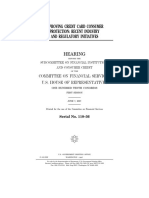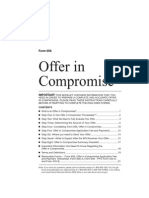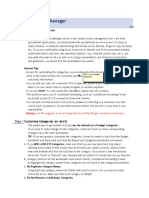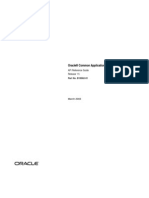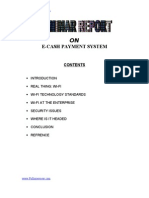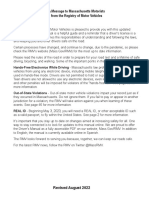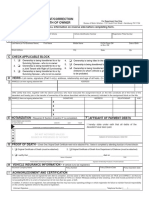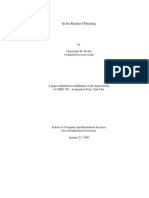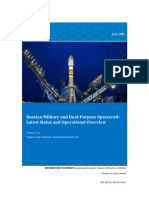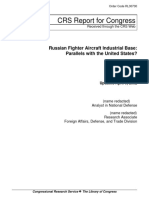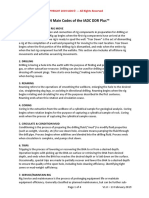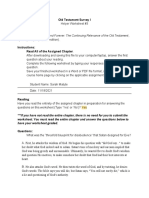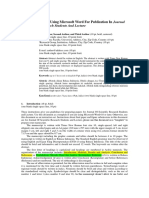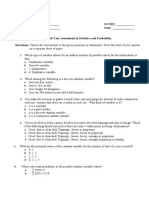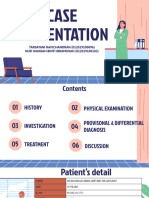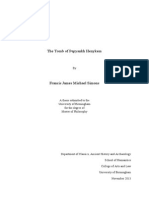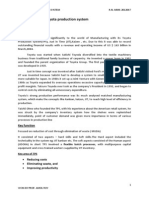Russia CP Michigan Debate 2011 1/35 7 Week Seniors
Uploaded by
Bryan Adam San MiguelRussia CP Michigan Debate 2011 1/35 7 Week Seniors
Uploaded by
Bryan Adam San MiguelRussia CP 1/35
Michigan Debate 2011 7 Week Seniors
Russia CP
Russia CP..................................................................................................................................................................1 RUSSIA C/P 1NC.....................................................................................................................................................2 PRIVATE SECTOR SOLVENCY..............................................................................................................................3 GEN SOLVENCY/A2: U.S. LEADERSHIP..............................................................................................................4 GEN SOLVENCY......................................................................................................................................................5 GEN SOLVENCY.....................................................................................................................................................6 GEN SOLVENCY......................................................................................................................................................7 SOLVES BETTER....................................................................................................................................................8 SOLVES BETTER....................................................................................................................................................9 SOLVENCYAEROSPACE RESEARCH...............................................................................................................10 SOLVENCYASTEROIDS.....................................................................................................................................11 SOLVENCYCOLONIZATION ............................................................................................................................12 SOLVENCYHUMAN MISSIONS........................................................................................................................13 SOLVENCYINNOVATION..................................................................................................................................14 SOLVENCYLAUNCH COSTS..............................................................................................................................15 SOLVENCYMARS SAMPLES.............................................................................................................................16 SOLVENCYMARS...............................................................................................................................................17 SOLVENCYMARS/MOON.................................................................................................................................18 SOLVENCYNUKE PROPULSION......................................................................................................................19 SOLVENCYRELIABILITY .................................................................................................................................20 SOLVENCYSCIENTISTS/ LABOR COSTS ........................................................................................................21 SOLVENCYSPACE DEBRIS...............................................................................................................................22 SOLVENCYTELESCOPE AFFS..........................................................................................................................23 SOLVENCYTOURISM........................................................................................................................................24 COOPERATION C/P SOLVENCYBMD/SECURITY/ASTEROIDS ...................................................................25 A2: U.S. KEY..........................................................................................................................................................26 A2: U.S. KEY..........................................................................................................................................................27 A2: NO MONEY.....................................................................................................................................................28 A2: COOPERATION PERM...................................................................................................................................29 A2: COOPERATION PERM...................................................................................................................................30 AFFPERMUTATION SOLVENCY......................................................................................................................31 AFFPERM SOLVES RELATIONS......................................................................................................................32 AFFNO SOLVENCY............................................................................................................................................33 AFFBUDGETS....................................................................................................................................................34 AFFNATIONALISM TURN................................................................................................................................35
Russia CP 2/35
Michigan Debate 2011 7 Week Seniors
RUSSIA C/P 1NC
Text: the government of the Russian Federation should _______ Russias space program is excellentits comparable to the US HARVEY 2007 (Brian, author of several books about space, The rebirth of the Russian space program: 50 years after Sputnik, new frontiers, p. 316) Despite all that, the Russian space program clawed its way back. In 2000 Russia regained its place as the top space-faring nation in numbers of rockets launched each year. When the American space shuttle Columbia burned up in 2003, it was Russia that kept the International Space Station going, smoothly and without fuss. Against the odds, Russia managed to: keep the Mir space station in operation until its safe de-orbiting in 2001; build the core modules of the International Space Station, Zarya and Zvezda, as well as supply a docking module, Pirs; send a regular supply of Soyuz and Progress missions up to the ISS, including new versions of both: the Soyuz TMA and Progress Ml models; maintain a military space program; sustain a space applications program. The Russian space program demonstrated a high level of adaptability to the new, difficult and uncertain economic conditions. This was most clearly demonstrated by: the establishment of a national space agency, the RKA, now Roscosmos; the turning around of the program from the most self-sufficient national program to the most globally competitive in the world; the attraction of significant foreign investment to sustain the manned and unmanned program; 87 space-based companies which entered joint ventures with American and European companies to sustain and develop their projects; the opening of new cosmodromes (Svobodny and Dombarovska), the development of new launching systems (Barents Sea) and a launch base in French Guyana; the adaptation of missiles to serve as launchers: Rockot, Start, Dnepr and Shtil; the introduction of new upper stages: Ikar, Fregat, Briz KM and Briz M. The Russian space program began to show the promise of new life: fresh groups of cosmonauts were recruited; the production line of the Soyuz and Proton rockets was increased; the Soyuz 2 series was introduced; progress was made in the preparation of a new family of rockets, the Angara. It is possible that 1997 marked the low point of the
extreme financial and organizational pressure inflicted on the Russian space program. Ten years later, Russia was in a better position to develop future projects. In 2005 the government approved a new federal space plan. Here we review its key elements, for they mark out the intended future path of Russian space exploration.
Russia CP 3/35
Michigan Debate 2011 7 Week Seniors
PRIVATE SECTOR SOLVENCY
The Russian government cooperates with a strong private space industry MODERN RUSSIA 2011 (Gagarins first flight continues to propel Russian space program, April 11, http://www.modernrussia.com/content/gagarinsfirst-flight-continues-propel-russian-space-program)
The Russian space program has come a long way since Gagarins flight, branching out into the commercial sector in private satellite launches and space tourism. Roscosmos the Russian Federal Space Agency now partners with its American and European counterparts on a number of initiatives. Private Russian companies work with international and domestic partners to further expand the countrys space industry, and that cooperation looks likely to only grow in the coming decades. Russian private space companies are strong DINERMAN 2005 (Taylor, author and journalist, Russia, space tourism, and exploration, Space Review, August 22,
that it couldnt be done or that the plans budget ($200 million) was unrealistic. In fact, the
http://www.thespacereview.com/article/435/1) Last week, when Space Adventures announced their plan to fly tourists around the Moon using hardware from Russias RSC Energia corporation, no one jumped up and said
Russians, through a combination of historical accidents, hard work, and hard-earned expertise, have established themselves as providers of robust, reliable, and low cost space hardware. Not only that, but the Russian space industrys success is a source of national pride. This allows them to make a few, modest demands on the Russian government for both political and financial support. The Russian civil space industry is not (except for the ISS) dependent on the government for its funding, and this has forced them to seek imaginative ways to stay in business, as well as to work hard on old-fashioned capitalist virtues, such as return on investment and strict cost and quality control. Protons success as a commercial satellite launcher is evidence that this sort of capitalism can pay off. Since 1991 they have rarely been able to lobby the Duma for any special earmarks. There have, of course, been lots of reports and rumors of corruption, but this has not led to the collapse of the space industry complex as happened with other Russian industries. Instead, they managed to take what was left of the Soviet space program and built it into a new force, committed to making money through international cooperation and commerce.
Russia CP 4/35
Michigan Debate 2011 7 Week Seniors
GEN SOLVENCY/A2: U.S. LEADERSHIP
The Russian space program is effective without challenging overall American leadership HARVEY 2007 (Brian, author of several books about space, The rebirth of the Russian space program: 50 years after Sputnik, new frontiers, p. x) The rebirth of the Russian space program coincides not only with Sputnik but with the announcement by the government of the federation of a space plan to last to 2015, an attempt to reinstitute goal-orientated planning in the program. If one looks at the number of launches per year, Russia remains the leading spacefaring nation in the world. At the same time, it is obvious that
the Russian Federation's space program has none of the ambition of the American space program, which has now sent extraordinary missions to all the corners of the solar system and plans to return astronauts to the Moon and send them onward to Mars. Unlike the 1960s and 1980s, present-day
Russia has neither the capacity nor the will to challenge American leadership of space exploration (the Chinese probably do, but that is another story). At the same time, Russia will remain one of the world's space superpowers, a builder of space stations, a formidable contributor to the world space industry and science. As this book shows, the Russian space program is full of activity and life. Fifty years after Sputnik, the dream lives on.
Russia CP 5/35
Michigan Debate 2011 7 Week Seniors
GEN SOLVENCY
CP solves the affRussia has a wide variety of space technology that allows them to do the plan Savelyev 04, Alexander Head of Sector Geopolitics of Strategic Analysis IMEMO Vice-President of the Institute of National Security and
Strategic Studies (INBSI), Prospects for US-Russian Cooperation in Ballistic Missile Defense and Outer Space Activities Journal of Slavic Military Studies 17: 99109, 2004, http://dx.doi.org/10.1080/13518040490440674 NEH) One should mention that the list of potential areas of US-Russian cooperation in outer space can be quite long. Thus, in
the sphere of information alone there are potential projects in the following areas, among others: developing a global space information security system; joint efforts to reduce the vulnerability of space-based systems; joint analysis and data exchange on space objects; the protection of space information streams; joint monitoring of informational threats to space systems; and monitoring the space in general (including radiation, intensity of the sun wind, the characteristics of the magnetic field and other factors which influence the transmission of information to and from space), and so on. The realization of prospective space technologies will make it possible to begin implementing large civil space projects by the end of the next decade. For example, a large portion of the efforts will go toward developing great space energy programs, whose goal is to prevent a coming energy and environmental crisis. In this connection, building and using orbital solar power stations and transmitting energy to the earth will be on the agenda of international cooperation in outer space. Space technologies can also help solve the problem of weather control, including the control of typhoons, and other unpleasant surprises. According to the views of some Russian experts, lasers under development for military use could also be used for such purposes. In particular, the Russian Rocket and Space Corporation, Energia (Energy), is studying such possibilities.9 In addition to the aforementioned, a number of other projects, such as space isolation of nuclear and toxic waste, counter-meteorite programs, production in space and others have good prospects. After 2020 manned flights to Mars and the construction of moon bases will also sound much less fantastic than today.
Russia CP 6/35
Michigan Debate 2011 7 Week Seniors
GEN SOLVENCY
Russia is the leader in spaceit has low production cost, strong political support, funding, and reliable technology ZIMMERMAN 2005 (Robert, award-winning space historian, Space Watch: The Russians Are Coming, Space Daily, Jan 28,
http://www.spacedaily.com/news/oped-05r.html) Think again. The
future of space in the next decade could just as easily be dominated by a resurgent Russian space industry, innovative and efficient, with the ability to provide quality service to its customers at a low cost. After the fall of the
eventually produced paid flights to the International Space Station by well-heeled tourists such as Dennis Tito. Because
Soviet Union in 1991, the Russian space program was the first business to face reality and shift gears, quickly adopting capitalistic and market-oriented techniques for making a profit. Almost immediately, advertisements plastered the walls of mission control in Moscow as well as the sides of Russian rockets. Russian cosmonauts taped commercials in orbit, and the space program sold tickets to Mir to television stations, entertainment consortiums and foreign governments -- including the United States. That effort
of an extremely favorable exchange rate leftover from their failed communist economy, Russian labor costs were significantly lower than those in the West, allowing them to charge significantly less than anyone else. Moreover, rocketry was one of the few Russian industries with a good reputation for high quality standards. Russia's space program soon became by far the country's most successful export product. By 2000, it had grabbed a significant share of the private commercial launch market with its Proton, Dnepr, Zenit and Soyuz rockets, and by last year it was so successful its rockets launched more than 45 percent of all spacecraft, more than any other nation and 50 percent more than the U.S. market share. The future looks even brighter. Last week, Roskosmos, the Russian space agency, signed a long-term agreement with the European Space Agency to allow Russia to establish Soyuz rocket-launch facilities at ESA's spaceport in Kourou, French Guiana. Because Kourou is closer to the equator than either Baikonur or Plesetsk -- the two launch pads from which the Soyuz rocket family is presently fitted to fly -- it will allow Soyuz nearly to double the payload it can lift to geosynchronous orbit, from 1.7 tons to 3 tons. At the same time, the Russians continue to hold the whip hand in their negotiations with NASA over shuttling
crews and providing lifeboat services to the space station. The next agreement between the two nations likely will give the Russians even more opportunities to sell tourist tickets each time they send a Soyuz to the ISS, a flexibility that will also "increase launch orders for our space industry," noted Roskosmos chief Anatolii Perminov at a news conference. With
such encouraging business prospects, it is not surprising the company that builds the Soyuz rocket family boosted its planned production for 2005 by 50 percent -- from 10 rockets to 15. Moreover, Roskosmos already has announced that, in the first three months of 2005 alone, seven Russian launches will put eight satellites in orbit, a launch rate far exceeding anyone else's. Even as they are solidifying their domination in the launch industry for both manned and unmanned missions, the Russian government seems firmly committed to complete the Russian half of the space station by 2011, with plans to launch a new laboratory module by 2007, a power and science platform by 2009 and a second laboratory module by 2011. The Russians also appear to be moving forward aggressively with their next-generation manned spacecraft. Roskosmos first announced it was beginning work on this new vehicle, dubbed Clipper,
shortly after President George W. Bush unveiled his space initiative on Jan. 14, 2004. In the year that followed -- while NASA could barely write the first draft of its Request for Proposals describing what it required for its shuttle replacement -- RSC Energia, the Russian space company, completed a preliminary design as well as a full-scale model, unveiling it last Dec. 1. Not only is this six-seat manned spacecraft intended to be reusable, but one design option also will have it land on a runway like the space shuttle. Furthermore, Energia officials said if funded they could have it built and flying by 2010. Topping all this, a number of Russian government and industry officials have expressed guarded optimism their
country will mount its own effort to send humans to Mars, sometime around 2015. Nor has this overview m entioned pending launches in 2005 on Russian rockets of cutting-edge solar-sail and space-mirror technologies. Obviously, it would be a mistake to assume the Russians have no problems at all. For example, Clipper's
Russians to Mars. Nonetheless,
funding situation remains unclear. Though RSC Energia officials said they could complete a fleet of four Clippers by 2010, the Russian government seems more inclined to stretch out its development until 2015. Moreover, unlike George Bush, Russian President Vladimir Putin has made no commitment to any large space effort, including sending
the Russian space industry's future appears rosy.
Russia CP 7/35
Michigan Debate 2011 7 Week Seniors
GEN SOLVENCY
Russias space program is rapidly improving DEUTSCHE WELLE 2010 (Russian space program on the rise, Nov 3, http://www.dw-world.de/dw/article/0,,6185232,00.html) The Russian space industry, which had become a shadow of itself after the collapse of the Soviet Union, is once again enjoying state support. The government has increased spending on the space industry by 40 percent for each of the past five years. In 2009, it received a record $2.8 billion. Russian Prime Minister Vladimir Putin also confirmed this fall that Russia's new $800 million Vostochny cosmodorome in the country's Far East should be up and running by 2015. "I must say that the construction of the new space center, commissioned in 2007, is one of the biggest and most ambitious initiatives in Russia today," he said in a speech earlier this year. "Not only will it confirm Russia's status as a technological leader and boost its potential in science and technology, but, just as importantly, it will allow hundreds, if not thousands, of young specialists to prove themselves, to show their talent, and to make their most ambitious plans come true." Russia is an international leader in spacethey have sufficient capabilities for the plan MODERN RUSSIA 2011 (Russian Space Program 50 Years After Gagarin, April, http://www.modernrussia.com/content/gagarins-first-flight-continuespropel-russian-space-program) On April 12, 1961, Yuri Gagarin was the first man to travel into outer space. Fifty years later, Russias initial 89-minute voyage. Through
space industry has come a long way from that constant innovation, the Russianspace program has grown from performing scientific experiments, to servicing the space station Mir, and nowto commercial satellite launches and space tourism. Below are some key facts about this industry, which is akey driver of innovation for Russia and the world. A G LOBAL L EADER IN S PACE Outer space has remained a preeminent focus in Russia, regardless of the economic situation.Vladimir Putin told the Russian space program leaders in July 2010: The space rocket field has been one of the state's priorities since its inception. Space has always occupied a special place for us, and Ihope it will continue to do so. And so, despite the difficulties we face because of the downturn, thespace sector received all the money originally allocated, in accordance with the approved programs. Speaking with the crew of the
International Space Station last year, PresidentDmitry Medvedev emph asized that space is one of our five big national technological modernisation priorities. This sums up completely the importance we place on (it). On April 5, 2011, Mr. Putins spokesman, Dmitry Peskov, told Bloomberg We
are increasing the spacebudget as the time has come for a technological breakthrough, adding that, We need to replace outdated infrastructure and continue to sup port the
flagship status of the space industry. According to the 2011 launch schedule,50 Russian spacecraft will be launched, and a federal program for the management of the GLONASS navigation system the Russian equivalent of the GPS system- will be adopted.Russia
has become the global leader in space launches, sending a total of 31 successful spacemissions in 2010, compared with 16 by the U.S. Russia ranks fourth in terms of funding of civil space activity, after the U.S., Europe and China. K EY P LAYERS Roscosmos:The Russian space program has undergone vast changes since a2004 initiative that allocated more money for space exploration and development. The agency is now
halfway through theFederal Space Plan 2006-15.The program allocated $8 billion over ten years for space programs, withadditional funds being supplemented for military and GLONASS systems. The plan also provides for70 non-military craft to be put in orbit by 2015. As part of the Space and Telecoms working group ofthe Presidential commission on Modernization and Technological Development of the Russianeconomy, Roscosmos is implementing a number of projects, including an emergency response systemfor potential problems with the ERA GLONASS system, and creating a complete production cycle for anew generation of solar panels.
Russia CP 8/35
Michigan Debate 2011 7 Week Seniors
SOLVES BETTER
NASA sucksRussia is more efficient RIA NOVOSTI 2005 (Russian Technology Can Put Cosmonauts on Moon, Dec 2, http://en.rian.ru/analysis/20051202/42288677.html) Despite Russia's 30-fold disadvantage in financing its space effort as compared with America's, it has greater chances of being the first in reaching the Moon this time, or perhaps the Mars. The paradox is that the Americans have put all their money in
the transport system being developed by NASA (the National Aeronautics and Space Administration) and its budgetary division. According to an article in the influential newspaper "The Washington Post" of November 24, the
American president's program of space research is having serious financial difficulties. Budgeted sums are just not enough. Most of them have been spent on upgrading the space shuttle system and looking
for causes of the Columbia disaster of February 1, 2003. Reports also say that the idea is mooted to abandon the shuttle program altogether and save money for lunar and Martian missions. But such a step is unlikely to meet the emerging deficit in NASA's budget, which may grow to $6 billion at the peak of preparations (2006-2010) for interplanetary expeditions. Only extra cash injections can allow the agency to develop and build a new generation manned spacecraft by 2012 that is necessary for a lunar mission scheduled by President Bush for 2020. At the moment, however, the White House is flatly refusing to commit any more money to the space effort. It
appears that American astronautics is hostage to fortune, in fact, to one of its own programs, or rather to the enormous sums sunk into its
American space projects. The likeliest explanation is the
implementation. However, the odds are that it is neither shuttle craft, which can be operational for a long interim period, nor the overspending, that are plaguing ambitious
sheer size of the task that keeps NASA from focusing on specific projects and grasping how much it needs to spend on each of them. Meanwhile, Russian technologies, despite falling well behind in financing terms, promise to put cosmonauts on the Moon's surface in seven to nine years' time, with the whole exercise to cost no more than $2 billion. "We could bring about a landing," said Nikolai Sevastyanov, president of the Energia Rocket and Space Corporation, "as early as 2012-2014 by using the technology of Soyuz-type spacecraft. If we had a $2 billion program, we could land on the Moon after mounting only three expeditions."
Russia CP 9/35
Michigan Debate 2011 7 Week Seniors
SOLVES BETTER
Russia can explore space more focused, making it solve better ELHEFNAWY 08, Nader, taught at the University of Miami, and has published widely on space and international issues. A Russian resurgence? (part two)
The Space Review, http://www.thespacereview.com/article/1251/1 NEH)
Russian Minister of Economic Development and Trade Elvira Nabiullina estimated last year that should her country manage to sustain its current rates of growth, it will have a roughly $5 trillion economy by 2020. This would make it the third largest economy in the world today (or even second, depending on how it stacks up in nominal terms), and the fifth in 2020, after only the United States and the Asian giants of China, India, and Japan. Russia would be a distant fifth, with about a quarter the GDP of China, here projected to be the leader of the pack. Nonetheless, it would also have a higher per-capita GDP than China and India, over $33,000 a head, on a par with many of todays First World nations. The countrys greater affluence (and a broad experience of being better off) would leave it in a position to commit a higher share of its national income to projects like exploring and developing space. Moreover, culture should not be totally ruled out as a factor. The experience of a broad improvement in living conditions aside, perhaps no country on Earth has derived as much of its national prestige from space as Russia. And perhaps nowhere does a futurist streak, especially one bound up with space, run more deeply than in
the nation that gave the world Nikolai Fedorov and Konstantin Tsiolkovsky, a point acknowledged by Brian Harvey in his writing on the Russian and Soviet space programs. All of these could well factor into the degree of commitment to a space program in which Russia has historically had no peer, as not only the exceptional Soviet-era investment in that program suggests, but also the survival of that program through the extraordinarily trying times of the 1990s. As a result, what seems overambitious from the standpoint of 2008 might begin to be practical by 2020 if things go well. Still, a return to Soviet-era funding levels even then (which would come within the realm of the possible if Russia achieves a $5 trillion GDP) is implausible. Barring truly extraordinary adroitness on the part of the Russian government in dealing with its developmental problems, these will absorb long overdue rubles. Additionally, the fact remains that even Soviet-era budgets would not return Russia to its earlier standing because the US and China would remain in a position to outspend it in any serious competition (barring a major upset like a sharp economic contraction due to rising energy prices, serious political instability in China, or a debt-and-currency crisis in the case of the US). And of course, even they will not enjoy the stature of the space superpowers of the 1960s, due to the broader diffusion of satellite ownership and space launch capabilities evident since the beginning of the space age. That process would still be more advanced today than it was in 1989, even if the Soviet Union had managed to thrive and survive into the twenty-first century; and it will be that much further along in 2020. The end result would be that rather than Russia (or any other state) being in a position to pursue clear-cut dominance in orbital space, or settling for being one of two (or three) leviathans surrounded by comparative minnows as remained the case during the Cold War, a successful and aggressive Russia will end up just one of the larger participants in a much broadened arena. The Russia described here is
still likely to be one of the worlds most prolific space launchers (if not the most), and one of the very few to go on operating a manned space program at any level, if dependent on existing rather than new system types and facilities. It is also likely to have a bigger budget and larger portfolio of space assets than India, perhaps leaving it with the
lives. More importantly, Russia would retain a robust base on which it could build, and a entirely ruled
third- or fourth-biggest budget and portfolio of assets (depending on how the European Union is measured, and also the level of effort Japan is willing and able to make). Russias constellation of satellites may not be very much larger in total numbers than it is now, but a larger part of it would be functional, operating within their normal service
return to something like Russian leadership may not be out should things continue to go favorably after that. This would especially be the case if Russias leadership displays more will and
insight on the issue at a fortuitous moment than other statesas was the case where rocketry was concerned in the late 1940s and early 1950s, when the United States
largely neglected these possibilities. While it is a long shot, the next space age may yet see its own Sputnik moment.
Russia CP 10/35
Michigan Debate 2011 7 Week Seniors
SOLVENCYAEROSPACE RESEARCH
Russian aerospace research makes it competitive with the US ELENKOV 1995 (Detelin S. Elenkov is a professor at the School of Management and Business and director of the Center for Eastern European Business and
Economic Research (CEEBER) at Adelphi University, Russian Aerospace MNCs in Global Competition, Columbia Journal of World Business, Summer) In short, the
strong Russian aerospace military sector was nurtured at the expense of the largely neglected civilian sector. Military-oriented R&D and production enjoyed preferential treatment and received special resources. At the same time, the civilian sector was assigned low priority. Hence, the determined political leadership has been one of the factors that have made the aerospace/military sector the most successful part of the Russian economy. Science and technology is also one of the fields in which Russia has done world-class work. For many years this country has directed much of its money and human talent into technical and scientific endeavors. According to recently published statistical data, Russia has about 1.7 million scientific workers and 7 million engineers, which is more than twice the numbers of trained scientists and engineers in the United States.[ 11] However, science and technology in the former Soviet Union were not really designed to advance the quality of human life, but to help in solving the problems specified by the authorities. That meant first and foremost supporting the aerospace/military programs. Russian expertise in space and military technology is well-known throughout the world. The success of the first Russian artificial satellite Sputnik 1 has become legendary. According to the U.S. Department of Defense, Russian military technology and products are roughly on a par with U.S. technology and products in areas such as aerodynamics, conventional and nuclear warheads, power sources and laser technology. In some strategic weapon systems, like ballistic missile defense and surface-toair missiles, the Russians have even appeared to excel.[ 12] It is a tradition in the Russian aerospace/military sector to implement designs that stress
simplicity, commonality, performance and economy. One example is the engine for the MiG-21 which contains about one-tenth as many parts as the engine used in F-4, its U.S. equivalent of the day.[ 13] As a result of the aforementioned historical developments, several Russian
companies associated with the aerospace/military sector have built a capability to offer high-performance products at prices significantly below the level of the competition. In order to study the specificity of competitive strengths, strategic priorities, and forms of multinational business
operations of these companies, I conducted exploratory research in Russia during the summer and fall of 1993 and the summer of 1994. In particular, I utilized a combination of interviews, direct observation and review of official company documents.
The Russian aerospace sector is excellenttheyre competitive with the US ELENKOV 1995 (Detelin S. Elenkov is a professor at the School of Management and Business and director of the Center for Eastern European Business and
Economic Research (CEEBER) at Adelphi University, Russian Aerospace MNCs in Global Competition, Columbia Journal of World Business, Summer) Furthermore, Russian
aerospace MNCs appear to be capable of finding extraordinarily rapid and resourceful solutions to problems of economic turbulence and social change. In fact, these companies have shown a tendency to expand, in a most opportunistic manner, into new markets in response to intractable problems associated with sourcing important materials; difficulties with output levels that exceed the requirements of the domestic market; or difficulties of finding basic services like banking, telecommunications, security and insurance in their home country.[ 22] Westerners have already recognized that Russia has many talented and experienced managers.[23] These managers still have no training in Western management theory and practice,[24] but their own Russian management style has its own considerable strengths including possession of elaborate information about the task environment, resourcefulness and pragmatism.[25] Russian executives included in this study have demonstrated that they possess elaborate information about indigenous markets, suppliers, networks, ministries, regulations, cultural patterns and work-force strengths and weaknesses. In brief, Russian aerospace MNCs have some distinct competitive advantages which have made it possible for them to overcome the existing obstacles of operating in foreign markets. The most important competitive advantages of these companies include possession of state-of-the-art technology, low R&;D and manufacturing costs, rapid development of full-scale manufacturing of new aircraft models, highly skilled and educated work force and pragmatic management.
Russia CP 11/35
Michigan Debate 2011 7 Week Seniors
SOLVENCYASTEROIDS
The Russian space program can deflect asteroids RUSSIAN PRESS DIGEST 2010 (RusData Line, Russia is developing equipment for exploration of a potentially dangerous asteroid, May 19) Russian scientists are promising to develop a cosmic device for exploration of a celestial body which, according to certain astronomers, presents a certain threat to life on Earth. On Tuesday, director of the Space Research Institute, RAS, academician Lev Zeleny, told journalists that the leading domestic enterprise in the rocket and space industry - Lavochkin Scientific Production Association, is creating a device for the exploration of the asteroid Apophis. "In 2029, the trajectory of Apophis will be at a fairly close distance from the Earth, and during the second cycle of movement, in 2036, there is a probability that it will collide with our planet," cautioned academician Zeleny.
According to him, the damage resulting from such a collision will be three times more severe than the destruction that was caused by the Tunguska meteorite. Scientists believe that the space object that caused the explosion near the Podkamennaya Tunguska River on June 30, 1908, was 50 meters in diameter and could have weighed 1-2 million tons. For comparison: the size of Apophis, discovered in 2004, is 270 by 60 meters, and the asteroid's total weight, according to various estimates, amounts to anywhere from 26 to 45 tons. The
likelihood that the giant cosmic "cobblestone" will collide with the Earth in 2029 is negligible: according to official estimates, published by NASA, the probability of a collision is 1 in 250,000. However, Apophis will "come near" our planet; according to the latest estimates, in 2029, the asteroid will pass the Earth's surface at a distance of 28,900 kilometers (give or take 200-300 km). Such proximity could have an effect on the orbit of a small celestial body. Deviation from the previous route could result in the Apophis to once again pass the Earth at a dangerously close distance 7 years later, in 2036. According to NASA, in the
event the "celestial guest" collides with the Earth, an explosion with the force of more than 500 megatons is possible (for comparison: the effects of the Tunguska meteorite's landing are estimated at about 10 megatons, which is equivalent to an explosion of a hydrogen bomb). Scientists, who based their estimates on a maximum possible size of the asteroid - 390 meters - concluded that if such a celestial body were to enter the Earth's atmosphere at a speed of 12.6 km/s, then the collision would form a crater on the Earth's surface of almost 6 km in diameter and trigger an earthquake, measuring 6.5 on the Richter scale, within a 10 km radius. If the asteroid falls into an ocean, it would result in an enormous tsunami; and, if a densely populated area is stricken, the destruction will affect several hundreds of kilometers. However, scientists note that even such a pessimistic scenario does not assume that this will be a global-scale catastrophe, similar to the one which led to the distinction of the dinosaurs - Apophis is simply too small for this. According to the hypothesis of a Nobel Prize laureate, Luis Alvarez, the "stone" that caused a nuclear winter 65 million years ago was about 10 km in diameter. "People's lives are in danger. It is better we spend a few hundred million dollars and create a system that will allow us to avoid a collision, than sit and wait for this to happen and thousands of people lose their lives," Anatoly Perminov, head of Russia's Federal Space Agency Roscosmos, warned the public in January of this year. However, astronomers say that one should not expect the end of the world to come in 2036; the probability Apophis will collide with Earth is very small, but, as was noted by academician Lev Zeleny, this is not a "zero probability". In order to obtain some more precise data on the behavior of the asteroid it was suggested to place a special beacon on Apophis. This, according to Mr. Zeleny, should be accomplished in 2029 as the asteroid approaches the Earth. "The beacon will make it possible to obtain very precise trajectory measurements of the asteroid, which will allow making a more precise forecast as to whether or not it will collide with the Earth 7 years later as well as taking the necessary measures to divert it from its dangerous course," explained the director of the Space Research Institute, RAS. The topic of protection of the Earth from the asteroid threat has not only been discussed within the scientific community for a long time, but has also become a part of the mass culture - take the Hollywood production, Armageddon, as an example, which was filmed six years prior to the discovery of Apophis in 1998. In the movie, an American expedition lands on an asteroid, as it approaches the Earth, and destroys it with a nuclear explosion. Scientists are offering measures for eliminating the uninvited celestial guest that are no-less-effective and, at a first glance, equally science-fictional. For example, the space device could deploy a "solar sail" - a thin light-reflecting film - on the asteroid. It is believed that the
pressure of electromagnetic rays could alter the asteroid's speed and direction. Experts of the European Space Agency proposed changing the
turn, the
trajectory of Apophis with the use of a special "orbit evacuator". The asteroid should be approached by a space ship, which will hover above it at the nearest possible proximity, which will be made possible by engines powered by solar batteries. The "cosmic traction engine" will pull the asteroid, while slightly accelerating is movement, and eventually bring the celestial body to a safer orbit. The development of such a "traction ship" or a "cosmic traction device" has been promised by the British corporation, EADS Atrium. In
Lavochkin Scientific Production Association, which has not only produced artificial Earth satellites devices for the exploration of Venus and Mars, but also intercontinental cruise missiles, could use its designs. However, as was noted last December by the head of Roscosmos, Anatoly Perminov, there are no plans to destroy the asteroid. "No nuclear explosions, everything will be done based on the laws of physics," stressed the head of the space agency.
Lunokhod-1, and
Russia will deflect asteroidsthe US wont take threats seriously THE BLADE 1-5-2010 (Preparing for Impact, lexis)
But the proposal to launch a ship to alter the course of a 885-foot chunk of rock speeding through space isn't a Hollywood creation, the asteroid in question is no longer
seriously expected to hit the Earth, and the would-be heroes are Russians, not Americans. Still, it's not such a bad idea. The asteroid, Apophis by name, originally was expected to have a 1 in 37 chance of hitting the Earth in 2029. Now it's expected to zoom by our little blue orb at a distance of no less than 18,300 miles. In galactic terms, that's still really, really close. NASA officials, however, are certain it will thought to be no more than a remote possibility. But
miss. Impact on subsequent close encounters in 2036 and 2064 is sooner or later, something big, flying through space at tens of thousands of miles per hour, is going to hit the Earth. It's only a matter of time. An asteroid that exploded more than five miles above Siberia in 1908 released the
equivalent of 185 Hiroshima-size atomic bombs and flattened 800 square miles of forest. That asteroid is believed to have been 120 feet in diameter. The asteroid thought to have the greatest chance of striking Earth in the future, 1950 DA, is more than 25 times larger. On a more hopeful note, the asteroid some scientists believe killed off the dinosaurs some 65 million years ago is thought to have been five to 10 times the size of 1950 DA. But considering
the potentially devastating effect of an impact of 1950 DA's size, it makes sense not to wait until the last minute to test asteroid-deflection techniques. So when the chief of Russia's space agency suggested recently that a joint mission to Aphosis might be in order, it was encouraging that Don Yoemans, head of NASA's Near Earth Object Program, welcomed the proposal but disappointing that he did not indicate a willingness to participate in the project. After all, by the time 1950 DA arrives in 2880,
Bruce Willis, who saved the day in Armageddon, will no longer be around to wrangle asteroids.
Russia CP 12/35
Michigan Debate 2011 7 Week Seniors
SOLVENCYCOLONIZATION
Russia is better at space colonization: resources and water harvesting Smith and Wilson 09, Tabitha and Wilson, Reporters for the School of Russian and Asian studies, Russia in Space, The School for Russia
and Asian studies9-29-09, http://www.sras.org/russia_in_space NEH) Beyond the realm of radio astronomy, funding for Russia's space analysts have talked about a
projects has boomed in recent years. As political and military "resurgent Russia" pushing its policy objectives on the back of rising oil prices, so too has Russia's space program been resurgent, striving to initiate and lead more projects on its own and with less assistance from NASA or the
European Space Agency. Russia's Federal Space Agency (which is often known by the shortened name Roscosmos) has set short-term (2015-2020) and long-term goals (2020-2040). Source for both graphs: Roscosmos.ru Anatoly Perminov, the current head of Roscosmos, has stated that industries
focused on building space vehicles and equipment are actually seeing growth during the economic crisis and that Roscosmos is continuing to implement its ambitious projects. Short-term plans include the Russian Virtual Observatory, an effort
to digitize and connect the various scientific databases in the countries of the former Soviet Union, and the OSIRIS project, a space telescope which would allow the locations of stars to be measured to far greater accuracy than they are today. Russia and India also hope to launch a joint
project to search for water on the moon. The space agencies believe that there may be water on the Moon because it is believed that the Moon was formed from material from Earth after Earth was struck by a meteor. Any material present on Earth
could have been transferred to the Moon. That water molecules exist on the Moon's surface has been confirmed by multiple space agencies. Although water in a form that would be usable by humans has not been found (such as deposits of ice), nobody has ruled out the possibility that it may exist. If
there is water on the moon, this would help advance what is the centerpiece of Russia's long-term space projects of placing humans in space for long-term missions and far-reaching exploration.
Russia CP 13/35
Michigan Debate 2011 7 Week Seniors
SOLVENCYHUMAN MISSIONS
Russia is increasing capability for human exploration Bryanski 4-7-11, Gleb, Reuters correspondant Russia targets bigger role for space program Reuters, http://uk.reuters.com/article/2011/04/07/science-us-russiaspace-putin-idUKTRE7366RB20110407 NEH) (Reuters) - Russia will boost its efforts to explore the solar system and seek a bigger share of the market for space launches in the next decade, Prime Minister Vladmir Putin said on Thursday. Speaking ahead of the 50th anniversary of Yuri Gagarin's pioneering space flight, Putin said Russia's plans go beyond transporting crews to the International Space Station. "Russia should not limit itself to the role of an international space ferryman. We need to increase our presence on the global space market," Putin told space and other government officials at his residence outside Moscow. Energy-rich Russia's space budget for 2010-2011 is 200 billion roubles ($7.09 billion), which Putin said made it the world's fourth-largest spender on space after U.S. space agency NASA, the European Space Agency and France. "Such resources enable us to set serious goals," Putin said. Putin said Russia currently provides some 40 percent of all space launches and wants to increase its share of what he said was a $200 billion market to as much as 50 percent in the near future. Russia, which has used the Baikonur Cosmodrome in ex-Soviet Kazakhstan for all manned launches since Gagarin's, would begin sending humans into space from a new facility it is building in Vostochny in eastern Siberia starting in 2018. "It is worth recalling that our automatic stations in the '50s and '70s were first in reaching the moon, Mars and Venus. These achievements are forever written into the history of space research," Putin said. "Now Russia
is returning to researching the planets of the solar system." The late Soviet cosmonaut Gagarin became the first human in space on April 12, 1961, orbiting Earth in a 108-minute flight that stunned the world and raised the stakes in the U.S.-Soviet space race. Half a century later, Russia is set to be the only country to take crews to space after NASA
mothballs its shuttle program later this year. A Russian Soyuz craft bearing Gagarin's portrait docked with the International Space Station early on Thursday (late on Wednesday GMT), delivering two Russians and an American astronaut to the orbital outpost. Russian space spending is far smaller than that of NASA, whose proposed budget for fiscal 2011 is $18.7 billion, but it has increased in recent years. Business daily Kommersant reported that Russia's 2007 space budget was $1.4 billion. But Deputy Economy Minister Andrei Klepach predicted Russia would face a space spending squeeze in 2015-2016 unless it makes long-term budget plans, through 2025, that would include moon research and other programs. MOON OR MARS? The country's space program has also suffered recent setbacks including the delay last month of a Soyuz launch to the International Space Station and two failed satellite launches this year. Scientists at the meeting were divided over the future direction of the space program and whether it should set its sights on the moon or Mars. Lev predicting a new space race because of the recent discovery of water there. "Where
Zelyony, director of Russia's Space Research Institute, said it should first focus on the moon, there are resources, there is always competition," said
Zelyony, who said two moon explorations are planned in 2013 but no money had yet been assigned for the missions. Vitaly Lopota, head of spacecraft manufacturer Energiya, said the United States was looking to Mars and Russia should do the same. "If we make the moon the priority we will lose in the long term," he said.
Russia CP 14/35
Michigan Debate 2011 7 Week Seniors
SOLVENCYINNOVATION
Russia is spurring space exploration and innovation OFlynn 10, Kevin, space policy analyst for Guardian, New space race hots up Russia & India Report, 5-4-10
http://indrus.in/articles/2010/05/04/new_space_race_hots_up.html neh)
A new space race is on as the balance of power shifts. The US and Russia are competing as well as cooperating as emerging powers like India and China join the fray On April 2, the Soyuz TMA-18 lifted off from the Baikonur Cosmodrome in Kazakhstan, carrying two Russians and one American to the International Space Station. Circling the planet, the crew will engage in intense cooperation, blithely indifferent to shifting power play on the ground. Russian-American space cooperation has increased recently. But its becoming clear that Russia will fuel space exploration once again, while the US will increasingly rely on Moscow to take its astronauts into space. Nasa has long spent more money on more programmes than Russias space agency. But President Barack Obama has dampened Nasas dreams of returning to the moon. At the same time, the Russian space industry is once more feeling the warm glow of state backing. There has been concerted investment in recent years, an investment that fits in well with the Putin doctrine of trying to restore Russian pride through capacity. The Russian government has increased spending on the space industry by 40% for each of the past five years, spending just under $2.8 bn in 2009, Euroconsult reported. Its like night and day, said Igor Lissov, editor of Novosti Kosmonavtiki (Cosmonautics News), comparing funding today with funding in the penurious Nineties. Putin launched an initial $10 bn programme for the space industry between 2006 and 2015. When Putin congratulated space industry workers in 2008 on Cosmonauts Day, he called on them to pursue really ambitious projects. The US Constellation human-flight programme was designed, according to President George W. Bush, to establish an extended human
presence on the moon that would then lead to flights to Mars. Obama cut it from the 2011 budget as the financial crisis snowballed and programme expenditure soared. The government said that though Nasa has already spent $9 bn on it, the programme is fundamentally unexecutable. Instead, the US will look to private companies to invest in future spacecraft. In the meantime, US
astronauts will hitch a lift on Russian spacecraft, a move that has Nasa supporters crying foul. Russian academic Yury Zaitsev told Interfax news agency that he thought the US would be dependent on Russia to transport its astronauts until at least 2020. In order to bring a craft to the standards of quality and safety for a piloted flight, you need years and years, he commented. Nasa has signed a $335 mn contract with the Russian Federal Space Agency (Roscosmos) for US astronauts to fly to the ISS in 2012. The new spirit of cooperation is a far cry from the start of the space race in the Cold
War era when space conquests of the USSR pushed the US to greater feats in space, such as the first man on the moon in 1969. As Russia braces to celebrate the 50th anniversary of Gagarins first flight on Cosmonauts Day on April 12 in 2011, the year of the Russian cosmonaut, Moscow however, must rethink its priorities, says Valery Kabusov, a former deputy head of Energiya, Russias rocket and space corporation. And while both countries feel they are the frontrunners, their dominance may well be challenged in the next decade by India and China as they ramp up funding of their own programmes. The Chinese launched for the third time its Shenzhou VII spacecraft and also their first spacewalk in 2008, while India is planning a manned flight by 2014. Some astronauts
and cosmonauts find nationalist rivalries distracting. Wouldnt it be better if all space-exploring countries got together to send a human-flight to Mars? I
have thought all my life that a flight to Mars is a great opportunity for humankind to move forward, says Alexander Serebrov, who flew into space three times for the Soviet Union and once for Russia. It has to be done through international cooperation. Meanwhile, the
Russian government has this year set aside 500m roubles ($17.2 mn) for the development of nuclear-powered spacecraft, which could be used for long-distance missions to the moon and Mars, explains Anatoly Perminov, head of Russias Space Agency, which is hoping that the new engines will be ready for use within nine years.
Vitaly Lopota, head of the Energiya corporation, added that the solar system could only be conquered on the basis of nuclear energy. Between 1970 and 1988, the Soviet Union sent 32 crafts into orbit that had thermo-electric nuclear-powered engines. But nuclear-powered spacecraft was outlawed by a series of international treaties in the Eighties due to fears of their potential collapse. Russian space officials now hope the treaties can be re-examined amid global plans for more long-distance space missions. Lopota assures that nuclear spacecraft would not be sent to orbits from which they could fall to the earth.
Russia CP 15/35
Michigan Debate 2011 7 Week Seniors
SOLVENCYLAUNCH COSTS
Russia already dominates space launches Laxman 11, Srinvas, space journalist at Moon Miners' Manifesto, Russia beats US and China Beyond the Moon and Mars 1-3-11, http://lunartiks.blogspot.com/2011/01/russia-beats-us-and-china.html NEH) THE COLD WAR RIVALRY IN SPACE MIGHT HAVE ENDED. BUT COMPETITION STILL EXISTS BETWEEN THE US AND RUSSIA What better proof of this than a recent statement put out by Roscosmos that Russia has surpassed not only the US, but also China in the number of launches last year. It provides an interesting account of how different space faring nations performed in the critical area of rocket launches in 2010. India with just three launches has fared better than South Korea, Japan and Israel.Of the three launches, two---both of the Geo Synchronous Satellite Launch Vehicle (GSLV)---flopped. Only the Polar Satellite Launch Vehicle on July 12,2010 succeeded. According to this report, in 2010, Russia has made almost
a half of all launches in the world this year - 31 launches of 74. Next there come the USA and China with 15 launches each. ESA has made 6 launches, India- 3, South Korea- 1, Japan 2, Israel -1. 4 launches in the world were unsuccessful. Out of 31 Russias launches, 15 have been made by the rockets produced by Khrunichev Space Center, including 12 of heavy-lift Proton. That is 2
times more than for Protons rival Ariane-5. Proton has also bet another record, with making 29 launches within 29 months.
Russia CP 16/35
Michigan Debate 2011 7 Week Seniors
SOLVENCYMARS SAMPLES
Russia is ready to collect samples on Mars RUSSIAN SPACE WEB 6-13-2011 (Phobos-Grunt gearing up for launch, http://www.russianspaceweb.com/) Russia's flagship planetary mission enters final phases of preparations for the journey to the Red Planet later this year. With the opening of a one-in-two-years window for Mars launches this Fall, Russian engineers plan to attempt sending their first probe beyond the Earth's orbit since 1996. After missing a previous launch window in 2009, a beleaguered Phobos-Grunt project was under an intense
former Roskosmos head, Anatoly Perminov, reportedly witnessed
pressure to fly this year, despite numerous technical challenges. The first real sign that the Russian space agency intended to go ahead with the launch of the Phobos-Grunt spacecraft in 2011 came in March, when the agency solicited bids to be submitted by May 20 for a contract to deliver a Zenit-2SB rocket for the mission from the manufacturer to the launch site later that year. Another published Roskosmos tender covered launch operations in Baikonur beginning in August 2011. During his visit to NPO Lavochkin, a
a test of the fully assembled soil-collection mechanism.
Russia CP 17/35
Michigan Debate 2011 7 Week Seniors
SOLVENCYMARS
Russia can get to Mars Arkhipov and Pronina 4/5 *ROE at FSUE Rosoboronexport AND **Bloomberg Reporter (4/5/2011, Ilya and Lyubov, Russia Speeds
Up Space Mission Plans as U.S. May Cut Spending, Bloomberg, http://www.bloomberg.com/news/2011-04-04/russia-speeds-up-moon-mars-plans-asu-s-may-cut-space-funds.html?cmpid=yhoo) MGM
Russia may be able to complete a Mars mission within 12 years if it is included in the new federal space program, Karash said. Roscosmos is working on a plan that will start in 2015, focusing more on outer space than before, Perminov said in the interview. A flight to Mars is more likely in cooperation with other space programs, according
to the Roscosmos plan. Roscosmos last June began a Mars flight simulation program, locking three Russians, two Europeans and a Chinese astronaut in 1,750 square-meter (18,800-square-foot), five-module complex to live there in isolation for 17 months. Russia will need a new rocket, a new
manned spacecraft for crews of between four and six members and a new launch site to operate manned flights as early as in 2018, Perminov said. The new rocket, Rus-M, which is to become Russias main vehicle for manned spaceflights, should be ready for the 2015 start of Russias new space program, he said. Cosmodrome Vostochny in Russias Far East will launch unmanned craft from the end of 2015, in line with the Roscosmos plan. The country will continue to use Kazakhstans Baikonur Cosmodrome until 2050. Russia is also considering building a new-generation orbital station,
according to Roscosmos.
Russia CP 18/35
Michigan Debate 2011 7 Week Seniors
SOLVENCYMARS/MOON
Russia has capabilities to land on Mars or the Moon ZAK 2011 (Anatoly, Russian space program: a decade review (2000-2010), June 8, http://www.russianspaceweb.com/russia_2000_2010.html)
a possible foundation for lunar and martian exploration, but only as a secondary goal. Instead, both Russian and European space
Not coincidently, during 2005 and 2006, the Russian space agency and its European partners rejected a proposal from the industry to build a new-generation reusable spacecraft, which would be best suited for operations in the low-Earth orbit. The idea of a new all-Russian space station fielded around the same time did get some traction as
officials favored the concept of a lunar-oriented project, known as ACTS. To be developed cooperatively in Europe and Russia, the future program would include a new spacecraft capable of entering lunar orbit and, eventually, a lunar lander designed to deliver humans on the surface of the Moon. Unlike the United States, Europe represented a natural partner for Russia, since the two sides have been closely involved in every aspect of economic cooperation from energy to aviation for more than a decade. During the first years of the 21st century, Russia's chief spacecraft developer, RKK Energia, served as a major contractor in the development of the
European ATV cargo ship, designed to resupply the ISS. Still mutually suspicious of each other, Europe and Russia would have to resolve difficult and politically loaded issues of rights and responsibilities in the new project. Given limited budgets for space, both sides needed each other to accomplish such an expensive and risky enterprise as a lunar expedition; yet, both had to keep their internal constituencies and industrial lobbies satisfied. On one side, Europe wanted independent access to space for its astronauts, instead of being a mere sub-contractor for traditional Russian spacecraft developers. On the other hand, Russia was adamant about preserving its own technical independence with a full complement of spacecraft, rockets and workforce to support it. Unlike post-Soviet 1990s, Russian space industry was no longer a beggar willing to take any paying job. All these conflicting political requirements could be as important as the reentry capsule's shape and the crew size for the future lunar ship. In the end, conflicting technical requirements backdropped by the tense political atmosphere between Europe and Russia in the wake of the War in Georgia in 2008, derailed a cooperative project. Still, according to the long-term planning of the Russian space program till 2040, manned missions
to the Moon could take place within a 20252030 time period, while an expedition to Mars could be achieved in 2035-2040. (321) This is despite a wisdom of going to the Moon first
was challenged by RKK Energia's planners, who hoped to accomplish an expedition to Mars during 2022-2035 period, pushing lunar exploration to 2030-2040.
Russia CP 19/35
Michigan Debate 2011 7 Week Seniors
SOLVENCYNUKE PROPULSION
Russia is developing nuclear propulsion for spacethis will allow asteroid deflection, colonization, and heavy satellite launches RT.COM 2010 (Russian nuclear rocket engine may get mankind to other planets, June 22, http://rt.com/news/sci-tech/nuclear-rocket-engine-space/) Humans on Mars and beyond and protecting the Earth from asteroids A new nuclear propulsion system to be used in spacecrafts is set to be developed in Russia. The technology will allow bigger vehicles to be sent into space, making manned missions to Mars possible. It will also mean new and more efficient type of satellites to monitor weather and gather intelligence. Its a kind of inter-orbital tow spacecraft for launching new heavy satellites and spacecraft to far-destined orbits, as well as to the Moon and other planets in the Solar system. At
present we have rockets with chemical fuel that can launch a vehicle weighing 5-6 tonnes. While these new vehicles will weigh two, or even four times more, explained Igor Afanasyev from Cosmonautics News Magazine. The Kremlin has set aside some 17 billion rubles to help develop a nuclear-powered rocket engine. 500 million rubles of that money are set aside for 2010. Russia's space company Energia, which helps to develop the engine, estimates the
new spacecraft could be tested by 2015. Currently rockets use solid or liquid fuel boosters, which are very energy-inefficient. With the new system, once the payload gets into space using conventional fuel, they can then stop using that booster and switch over to the new nuclear-powered drive that has the potential to bring payloads to much greater distances. That is something that can help get payloads to the ISS, and this is even more important, as the US space shuttle program is going to end in 2010 and not resumed until 2015. It also has implications for getting mankind even further to the Moon, possibly to Mars, and even exploration further in the cosmos. This new technology also has potential applications for military defense. For instance it could be used to monitor troop
movements in the field. But what rocket and space corporation Energia is trying to really stress is the new systems civil defensive potential. Some media outlets have misinterpreted our words on the application of the system saying it might be used to propel a military spacecraft with offensive capabilities into space. In reality the
system will help provide communications in regions hit by natural disasters and military conflicts. It will also be used to avert an asteroid threat and to monitor our territories, Energias statement says.
Russia CP 20/35
Michigan Debate 2011 7 Week Seniors
SOLVENCYRELIABILITY
The Soyuz launch system is 100 times more reliable than US equivalents PRAVDA 2010 (Soyuz 100 Times More Reliable Than Shuttle, Feb 8,
http://www.spacedaily.com/reports/Soyuz_100_Times_More_Reliable_Than_Shuttle_999.html) Richard Garriott, a videogame developer, who once boarded
Russia's Soyuz rocket for a space flight said that the Russianmade ship was much more reliable than its foreign analogues. Garriott, whose father is a former NASA astronaut, paid $30 million for a flight to the iInternational Space station. He said in a televised conference that Soyuz was 100 times more a reliable spacecraft than USA's shuttles.
Russia CP 21/35
Michigan Debate 2011 7 Week Seniors
SOLVENCYSCIENTISTS/ LABOR COSTS
Russian scientists are better educated, better at solving complex problems, and cheaper Belew 10, Bill, Political blogger on Asian affairs, Russia has the best Nerds 10-22-10, http://www.panasianbiz.com/asia/asia-only/russia-hasthe-best-nerds/ NEH) I read not long ago that Russia has more than 250,000 software engineers. Additionally, they have more scientists per capita than India, which has nearly 10 times the population! The Soviet Union created a high-quality education system, out of which came
mathematicians, scientists and engineers for designing space and weapons systems as well as other scientific, security and military developments. I visited a museum in Moscow once a sort of bragging center for the then Soviet Union. Every pavilion displayed something that looked like it was made in the 50s in the US. But then I went to the space pavilion. Whoa! Russia does not need to take a back seat to anyone when it comes to space. So, where have all the rocket scientists gone? (Is anybody singing now?) They are moving into the IT field. Russians are also well known for their ability to handle difficult and complex projects, even the one of kind solutions that require some serious jury rigging. I think the Russian word is finagle. If it isnt, it should be. For nearly 1/7th cost, hiring a Rusky for outsourcing needs couldnt sound much better, now could it?
Russia CP 22/35
Michigan Debate 2011 7 Week Seniors
SOLVENCYSPACE DEBRIS
Russia is solving space debris in the status quo Eaton 10, Kit, science and technology analyst for FastCompany.com, Space Debris? Russia's Got It Covered 11-24-10
http://www.fastcompany.com/1705137/space-debris-meh-russias-got-it-covered?partner=rss NEH) Russia has announced it will be investing $2 billion in a program to capture some
of the thousands of pieces of dangerous debris that threaten the future of space technology. How might it work? Energia, Russia's space corporation, has revealed plans to build a special space "pod" which will grab around 600 defunct satellites and then safely deorbit them so that they either burn up in the atmosphere or splash down into the ocean. The pod will rely on a nuclear power core, and cost around $2 billion to develop and deploy. Energia plans to complete design and testing by 2020 and have it in service no later than 2023, with an operational lifespan of around 15 years. The company also said it has been working on a space interceptor capable of tackling any dangerous objects from the outer solar system that may be on a collision course with Earth. If it seems odd to think of Russia as Earth's space junk and comet defender, it's also welcome news. Space debris in the form of defunct or malfunctioning satellites is an increasingly severe problem. Numerous orbits are becoming inaccessible,
or at least hopelessly dangerous, because of wandering hulls or showers of shredded metal debris--like the one caused by a collision between a working U.S. Iridium satellite and a dead Russian Cosmos satellite in 2009. How might the system operate? Energia hasn't offered much in the way of details, but its
long mission life span and nuclear power source point to its drive tech. Radio thermal space waves can generate electricity over a long time, making it an ideal power source for ion drives (which use electric fields to accelerate ionized gas, rather than the typical chemical rockets). The pod's stated targets, dead satellites, also suggests it won't use an exotic form of debris capture, like a space net. Instead it's more likely to power its way up to a dead satellite in or near its main orbit, and then use the ion drive to gently push the spent vehicle into a decaying orbit that'll end with a burn-up. Similar technology could be used in the "interceptor" spacecraft, only on a bigger scale. If you can identify and encounter an incoming threatening comet in time, you may only need to deviate its trajectory by a tiny amount so that it misses Earth rather than hits it.
Russia CP 23/35
Michigan Debate 2011 7 Week Seniors
SOLVENCYTELESCOPE AFFS
Russia cp solves your telescope aff better Space Daily 06, Russia Wants To Build Telescope Superior To Hubble 9-22-06,
http://www.spacedaily.com/reports/Russia_Wants_To_Build_Telescope_Superior_To_Hubble_999.html NEH)
Russia will build a deep space exploration telescope that will outstrip the U.S.-made Hubble Space Telescope, a Russian astronomer said Tuesday. Hubble, orbited in 1990, has been the most successful and expensive project in astrophysics, costing over $6 billion. "In cooperation with our colleagues from Germany, the United Kingdom, China and Spain, we have set ourselves the task of building the Spectrum-Ultraviolet telescope, which will surpass Hubble in some aspects," Boris Shustov, director of the Astronomy Institute at the Russian Academy of Sciences, told a news conference. The expert said the telescope, with a 170centimeter diameter antenna, will explore the structure of the universe in the ultraviolet spectrum. Shustov said that under the government's federal space program for 2006-2012, Russia is to implement two other large projects - the launch of telescopes operating in other spectrums, the Spectrum-Radioastron and the Spectrum-X-Ray-Gamma. The
Spectrum-X-Ray-Gamma telescope will study galactic clusters, and consequently, the structure of the universe. The Spectrum-Radioastron aims to study the structure of galactic and extra-galactic radio wave sources, their internal processes and other processes occurring near them.
It will comprise a space telescope and a ground tracking station. "If the antenna of the radio-telescope is 300,000 kilometers (187,500 miles) from the Earth, and the other telescope is on the Earth, they will represent one gigantic telescope," Shustov said. "The Spectrum-Radioastron project will make it possible to read a newspaper on the Moon."
Russia CP 24/35
Michigan Debate 2011 7 Week Seniors
SOLVENCYTOURISM
Russia can expand space tourism RIA NOVOSTI 2010 (Putin To Discuss Russian Space Program With Industry Officials, July 20,
http://www.spacedaily.com/reports/Putin_To_Discuss_Russian_Space_Program_With_Industry_Officials_999.html)
Russia plans to increase its share in the global space market by designing new models of unmanned and manned spacecraft, participating in a large number of international space projects and building a new space center. Russian Soyuz and Progress spacecraft will continue to play a crucial role in maintaining the International Space Station after NASA folds its outdated shuttle program later this year. The Energia corporation recently said it had the capacity to build five Soyuz spacecraft per year instead of four, meaning that at least one Soyuz spacecraft could be used for space tourism purposes in the future Increases in launch capacity solve space tourism Arkhipov and Pronina 4/5 *ROE at FSUE Rosoboronexport AND **Bloomberg Reporter (4/5/2011, Ilya and Lyubov, Russia Speeds
Up Space Mission Plans as U.S. May Cut Spending, Bloomberg, http://www.bloomberg.com/news/2011-04-04/russia-speeds-up-moon-mars-plans-asu-s-may-cut-space-funds.html?cmpid=yhoo) MGM The need to accommodate expanded crews has halted travel by paying space tourists 2009, Perminov said, adding
that space tourism may resume in 2013. Astronauts from other countries have to wait in line as demand for flights to the ISS is growing and Russias capacity is limited by the number of spacecraft, Perminov said. Russia would be able to earn $1 billion a year if it could carry out all requested launches, including commercial flights on its Proton and Soyuz rockets, he said. It would be good to have two, three or more tourists a year, Perminov said. Roscosmos is in talks with Russian spacecraft maker RKK Energia to increase production, he said.
Russia CP 25/35
Michigan Debate 2011 7 Week Seniors
COOPERATION C/P SOLVENCYBMD/SECURITY/ASTEROIDS
CP solves (BMD/Space security/asteroids) and boosts US-Russian relations Savelyev 04, Alexander Head of Sector Geopolitics of Strategic Analysis IMEMO Vice-President of the Institute of National Security and
Strategic Studies (INBSI), Prospects for US-Russian Cooperation in Ballistic Missile Defense and Outer Space Activities Journal of Slavic Military Studies 17: 99109, 2004, http://dx.doi.org/10.1080/13518040490440674 NEH)
Space presents realistic opportunities for US-Russian cooperation. But how can the two countries cooperate while also
protecting their own national interests? Can the US afford to go it alone in space? What will be the long-term effect of the commercialization of space?
Faced with ever declining space-technology budgets, Russia needs international cooperation if its space industry is to survive. At the same time, the US has shifted its interests away from cooperation and toward the military aspects of space. Further, the author says, the US has been inclined to solve problems unilaterally. But the author contends that the US is critically dependent on Russian launchers and that both countries would benefit from mutual efforts and expertise. Potential areas for joint work include ballistic-missile defense, protecting space-based systems, and data exchange on space objects. All of the foregoing, the author notes, would support national and international security. The history of cooperation in outer space between the US and the USSR, and the US and Russia, proves that successful and effective joint work between the two leading space states is possible and that it can lead to implementation of different space-related projects of various levels.
Russia CP 26/35
Michigan Debate 2011 7 Week Seniors
A2: U.S. KEY
The Russian space program is more reliable than the U.S.funding is up and new tech is coming online BOYLE 2005 (Alan, science editor for msnbc.com, Russia Thriving Again on the Final Frontier, Sep 29,
http://www.msnbc.msn.com/id/9509254/ns/technology_and_science-space/t/russia-thriving-again-final-frontier/)
What a difference four years makes: In 2001, when Mir plunged out of orbit, it looked as if Russia's space program was going down with it , scraping by on a budget of less than $200 million a year. Today, boosted by Russia's oil revenue, the government has committed to a 10-year plan for space exploration, funded to the tune of $1 billion a year. That's far less than the price tag for NASA's 13-year, $104 billion plan to return to the moon. But while America's space effort is struggling with safety issues and tight budgets, Russia is now seen as having the world's safest, most costeffective human spaceflight system. Like NASA, the Russians plan to develop a new breed of spaceship: a winged craft called the Kliper, capable of carrying a crew of six and built in partnership with the European Space Agency. Like NASA, the Russians plan to work toward lunar landings in the latter half of the next decade, leading to the establishment of permanent moon bases as steppingstones to Mars and beyond. Unlike NASA, the Russians plan to keep selling tickets to space, seeing it as a way to boost both budgets and public perception of the space program. Their goals are ambitious here as well, with plans to sell a trip around the moon for $100 million a seat . Of course, the Russian space effort has never suffered from a shortage of grand plans. Among the ideas floated in the past are
the Enterprise commercial space module, the free-flying Mini Station 1, the Marpost spacecraft for Martian exploration and yet another bargain-basement Mars mission . Nothing ever came of any of these. "There are many more plans available than money," Karash observed. This
time, however, Russia's plans sound more ... well, down to earth. Nikolai Sevastianov, the president and general designer of Russia's Energia rocket company, outlined for MSNBC.com a development program that for the most part builds on tried-and-true hardware design. Energia, the Russian space
which will be part of the ISS, Sevastianov said, estimating that the Russian side of the station could be complete in 2011. He said Russia's
industry's equivalent of the Boeing Co. and Lockheed Martin Corp., is heavily involved in the space station construction. "We are planning to build three additional modules
10-year space roadmap called for an expansion of satellite operations, drawing upon commercial as well as state funding. New lines of launch vehicles, such as the Angara rocket, would take their place alongside an upgraded version of the Soyuz rocket, Russias traditional launcher for manned spaceflight.
Russia CP 27/35
Michigan Debate 2011 7 Week Seniors
A2: U.S. KEY
Their evidence is biasedthe US has underestimated Russian space programs for fifty years ZIMMERMAN 2005 (Robert, award-winning space historian, Space Watch: The Russians Are Coming, Space Daily, Jan 28,
http://www.spacedaily.com/news/oped-05r.html) Nowhere in his presentation, however, was there any mention of a Russian system, even though since
1971 the Russians have built seven successful space stations prior to the ISS with a remarkable track record of efficient and practical atmospheric and water recycling systems. When asked by this reporter why he had left the Russians out of his presentation, he explained that he did not take their systems very seriously. "We don't have faith in them," he said. To put it mildly, when it comes to space exploration, U.S. space officials have deve loped the annoying habit of underestimating the Russians. In 1957, the Soviet Union made no secret of its plans to put a satellite in orbit as its contribution to the International Geophysical Year, a worldwide research event organized by scientists from July 1957 through December 1958. No one in the United States government paid much attention, and so the nation was shocked when Sputnik suddenly appeared in orbit on Oct. 4, 1957. Nothing, it seems, has changed in nearly 50 years. With all the talk about space tourism and Bush's space exploration initiative, it becomes crucially important to recognize the competitive nature of nations, and how the United States is not the only country with a desire and skills to colonize the solar system. So it might be prudent to consider the possibility that the first humans to reach Mars might be speaking Russian -- not English -- when they get there.
Russia CP 28/35
Michigan Debate 2011 7 Week Seniors
A2: NO MONEY
Russian space funding has increased dramatically ZAK 2011 (Anatoly, Russian space program: a decade review (2000-2010), June 8, http://www.russianspaceweb.com/russia_2000_2010.html)
conflict across the world. One
In May 2001, a respectable American magazine published an apocalyptic prophesy entitled "Russia is Finished." Intellectualizing the conventional wisdom of the 1990s, the article confidently promised "the unstoppable descent of a once great power into social catastrophe and strategic irrelevance." Little did the editors of the publication know that just a few months later, the only remaining superpower would be hit with the worst terrorist attack in its history, dragging its government into a protracted and costly
of the unintended consequences of the post-September 11 global instability, combined with economic boom in Asia, became soaring oil prices, which quickly turned Russia's natural resources-driven economy from bust to boom. With the Kremlin coffers full with oil revenues, the Russian government managed not simply to postpone a "social catastrophe," but to take steps to reverse its "strategic irrelevance." On the international stage, Russian President
Vladimir Putin made his official doctrine the creation of a "multi-polar world," which would challenge America's military and economic dominance. By the end of his two terms in office, President Putin consolidated so much power in his hands that he could make his old secret service bosses red with envy. Putin promised to use his new financial and political muscle to repair Russia's battered economy and military might. In 2006, Russian military spending approached 600 billion rubles, or double of its annual budget in 2000. (240) By the end of 2007, a Russian aircraft carrier group was heading back on patrol of the high seas, in a rare show of military power since the end of the Cold War. Strategic bombers, land- and submarine-based ballistic missiles resumed regular doomsday rehearsal missions. Oil
money also started trickling down into the previously underfunded space industry. To the delight of Russian space officials, increased funding was accompanied by President
Putin's declaration that "...without astronautics, Russia can not compete for one of the leading positions in the world's civilization, and will not be able to provide its defense at a necessary level." (270) To
restore Russian presence beyond Earth, the Putin administration started drafting the nation's long-term space strategy. On October 22, 2005, the Russian government signed a decree No. 635, approving Federal Space Program for 2006-2015 and worth 305 billion rubles. (299) The industry was directed to propose its projects and plan its activities in the timeframe of a two-phase Federal Space Program, FKP: Short-term projects and goals until 2015-2020 Long-term projects planning for the period 2020-2040 The Russian space budget continued growing during the 2000s, almost doubling by 2009. Russian space program has lots of cash REUTERS 4-10-2011 (Analysis: Stagnation fears haunt Russian space program, http://www.reuters.com/article/2011/04/10/us-russia-space-gagarinidUSTRE73910C20110410) Addressing concerns about Russia's role, Prime Minister Vladimir Putin
said on Thursday the country could take pride in handling over 40 percent of global space launches but must not be confined to the role of a "ferryman." "Now Russia is returning to researching the planets of the solar system," he said. Russia's space agency will receive $753 million to ferry 12 U.S. astronauts to the space station from 2014-2016, NASA announced last month. Russia raked in some $2.5 billion from NASA and partner agencies for 42 seats on Soyuz craft from 2007. Russia has increased space spending by some 40 percent per year during the last five years, according to Euroconsult, a consulting body that tracks the industry. It has earmarked 200 billion roubles ($7 billion) for space programmes from 2010-2011. Some of the money will fund a new launch facility in Vostochny
in far eastern Russia, where the first launches are anticipated in 2015 and the first manned launch in 2018.
Russian space program is effective even with less money BOYLE 2005 (Alan, science editor for msnbc.com, Russia Thriving Again on the Final Frontier, Sep 29,
http://www.msnbc.msn.com/id/9509254/ns/technology_and_science-space/t/russia-thriving-again-final-frontier/)
What a difference four years makes: In 2001, when Mir plunged out of orbit, it looked as if Russia's space program was going down with it , scraping by on a budget of less than $200 million a year. Today, boosted by Russia's oil revenue, the government has committed to a 10-year plan for space exploration, funded to the tune of $1 billion a year. That's far less than the price tag for NASA's 13-year, $104 billion plan to return to the moon. But while America's space effort is struggling with safety issues and tight budgets, Russia is now seen as having the world's safest, most costeffective human spaceflight system. Long-term budget plans like the CP are critical to maintaining Roscosmos funding Osborn 4/8 the Daily and Sunday Telegraph's Moscow correspondent (4/8/2011, Andrew, Russia plans moon base, Mars mission, Daily
Telegraph/Reuters, http://www.vancouversun.com/technology/Russia+plans+moon+base+Mars+mission/4580202/story.html) MGM
Russian space spending is far smaller than that of NASA, whose proposed budget for fiscal 2011 is $18.7 billion, but it has increased in recent years. Business daily Kommersant reported that Russia's 2007 space budget was $1.4 billion. But deputy economy minister Andrei Klepach predicted Russia would face a space spending squeeze in 2015-2016 unless it makes longterm budget plans, through 2025, that would include moon research and other programs.
Russia CP 29/35
Michigan Debate 2011 7 Week Seniors
A2: COOPERATION PERM
Space cooperation is badcompetition benefits both the US and Russia PRAVDA 5-20-2010 (International Cooperation in Space Is Impossible, http://english.pravda.ru/science/tech/20-05-2010/113443-space_cooperation-0/)
In the past, space exploration programs were based on national ambitions of the states which conducted those programs. The ambition to show the power of its science and technology made the Kremlin launch the worlds first-ever satellite and then first man in space. The White House stunned the world with its Apollo program. The
defeat of the USSR in the lunar race made Soviet scientists develop orbital stations Salyut and Mir. The success of the Soviet Union at this point was so impressive that it made the United States proceed in the same direction. In 1984, Ronald
Reagan announced the start of works to develop Space Station Freedom with the participation of Americas friends and allies. Russia Today: Russian space agency to dictate terms Tom Moser, the director of the program, clearly stated in 1987, when he tried to convince the Congress to fund the orbital complex, that Space Station Freedom would be developed to leave the Russians behind. The construction of the station with the participation of international partners was supposed to show that free nations could cooperate in space as successfully as communist ones (the Soviet Union was working on the Interkosmos program in cooperation with its political allies during those years).
The end of the cold war and the space race deprived the USA of its goals. Moreover, it turned out that coordinating efforts of different countries in one space project was a very complicated objective. Space Station Freedom
was supposed to enter orbit at the end of the 1980s. However, the designers of the complex, who had already spent $8 billion on engineering works, could only present a pile of documents to the president and the Congress. The program was eventually scrapped in the beginning of the 1990s. However, NASA suggested the White House should invite Russia in the project to celebrate the start of the new era in US-Russian relations and to build the complex faster, better and cheaper. NASA believed that Russias participation in the construction of the station, which was called the ISS, marked an obvious achievement both from the political, technological and economic point of view. US specialists thought that Russia would help save one year and $2 billion. In total, the construction of the ISS was evaluated at $17.4 billion. Russia helped in the solution of two vital problems in the program. It provided the service module (SM) known as Zvezda (Star) and Soyuz spaceships. The module, which provided some of the stations life support systems, was launched to the station four years later that planned. US congressmen calculated that the delay resulted in the losses of $5 billion. Russia was primarily responsible for the delay in the start of the exploitation of the complex, not to mention the increased spending. US congressmen repeatedly offered to either exclude Russia from the ISS program or simply purchase its service module. Now it is obvious that if Russia had been deprived of its membership in the program, the space station would have stopped operating after the crash of Shuttle Columbia in 2003. Russias Soyuz and Progress booster rockets remained the only option to deliver cargoes and astronauts to the space station before NASA resumed shuttle launches. The fate of the ISS will solely depend on the Russian rockets after 2010, when the shuttle program is shut down completely. If Columbia had not crashed, astronauts would have continued flying to the ISS and back on board NASAs shuttles, whereas Russias role would have been much less important. The the USA made
problems connected with international cooperation between the members of the ISS project and their dependence on Russia and NASAs John Logsdon come to conclusion that the ISS program experience was negative for its
members. As for the international cooperation in post-ISS projects, Barack Obama traditionally sees his major objective at this point in preserving Americas leadership
in the organization of international efforts to explore the Moon, Mars, etc. Unlike Russia, the USA has no official document related to the space exploration program that would stipulate the nations future dependence on cooperation with other countries. The possible consequences of such dependence can be seen in the canceled program of another manned flight to the moon. If the USA had accepted Roskosmoss request to include Russia in the project, the results would have led to lamentable consequences for Russia. Michael Griffin, a former head of NASA, said in 2006 that cooperation works best only if it is based on you-pay-for-yourself principle. Russia would have ended up with nothing if it had been accepted. A
look back at the history of space exploration clearly shows that most significant and technological progress was achieved at the time when it was connected with the solution of strictly national, not international problems of space exploration. Superpowers used space technologies to demonstrate their scientific and technological strength. This competition gave a powerful incentive to the development of space industries in Russia and the United States. International cooperation in space nowadays is impossible. Cooperation is badonly competition can sustain space programs DAWN.COM 4-11-2011 (Stagnation fears haunt Russian space programme, http://www.dawn.com/2011/04/11/stagnation-fears-haunt-russian-spaceprogramme.html) But much of that initial
rapture has now faded, leaving nostalgia among many in Russia for the days when the struggle between the two nuclear-armed superpowers fuelled and financed the pursuit of new horizons in science. US astronauts and Russian cosmonauts were never enemies in space, but when we began cooperating on the ground they cut the funding, said veteran cosmonaut Georgy Grechko, 79. Even the Americans would call us and say launch something new, so theyll give us money. With competition eclipsed by coperation, Russias space agency has survived over the past two decades by hiring out the third seat aboard the Soyuz to foreigners. Cooperation is good, but as the example of the international space station shows, it also leads to stagnation, Russian space policy analyst Yuri
Karash said, according to state-run news agency RIA. Gubarev said Russia had fallen so far behind it could achieve little better than a supporting role today in the most cutting-edge projects. In the meantime, America will take its time out and build an entirely new spacecraft, so that five or six years down the line our Soyuz will be entirely redundant, he said. No serious money is spent on breakthrough projects. Experts say China could soon challenge both Russia and the United States in space. The most important role will be played by our Russian Soyuz craft now. But we cannot discount the Chinese, who are following their own path and doing all this independently, Shamsutdinov said. NASA officials have voiced worries that the current budget financing will not be enough to fund a new rocket and capsule system for deep space travel. NASAs proposed budget for fiscal 2011 is $18.7 billion, some five times higher than Russias. Russian industry insiders say President Barack Obamas decision to halt work on NASAs next-generation Orion capsule threatens to take the wind out of a parallel Russian effort to design a replacement for the Soyuz that can fly beyond the International Space Stations low 354-km (220 mile) orbit. A little residual training centre after chalking up a record 803 days in space, said.
competition is a good thing, Sergei Krikalev, 52, who heads Russias cosmonaut
Russia CP 30/35
Michigan Debate 2011 7 Week Seniors
A2: COOPERATION PERM
U.S.-Russian competition is key to the Russian space program REUTERS 4-10-2011 (Analysis: Stagnation fears haunt Russian space program, http://www.reuters.com/article/2011/04/10/us-russia-space-gagarinidUSTRE73910C20110410)
But much of that initial rapture has now faded, leaving nostalgia among many in Russia for the days when the struggle between the two nuclear-armed superpowers fueled and financed the pursuit of new horizons in science. U.S. astronauts and Russian cosmonauts "were never enemies in space, but when we began cooperating on the ground they cut the funding," said veteran cosmonaut Georgy Grechko, 79. "Even the Americans would call us and say 'launch something new, so they'll give us money.'" With competition eclipsed by cooperation, Russia's space agency has survived over the past two decades by hiring out the third seat aboard the Soyuz to foreigners. "Cooperation is good, but as the example of the international space station shows, it also leads to stagnation," Russian space policy
analyst Yuri Karash said, according to state-run news agency RIA. Gubarev said Russia had fallen so far behind it could achieve little better than a supporting role today in the most cutting-edge projects. "In the meantime, America will take its time out and build an entirely new spacecraft, so that five or six years down the line our Soyuz will be entirely redundant," he said. "No
serious money is spent on breakthrough projects."
Russia CP 31/35
Michigan Debate 2011 7 Week Seniors
AFFPERMUTATION SOLVENCY
Doing both solves betterredundancy is good and doesnt cause competition BOYLE 2005 (Alan, science editor for msnbc.com, Russia Thriving Again on the Final Frontier, Sep 29,
http://www.msnbc.msn.com/id/9509254/ns/technology_and_science-space/t/russia-thriving-again-final-frontier/)
Although Russia and the United States have the same targets in mind the moon, Mars and beyond there's virtually no chance of a new international space race breaking out. Instead, the Russians seem to be positioning themselves for a place in an internationalized space exploration initiative. "If there would be such a concept adopted by the international community, certainly with an appropriate decision on the U.S. side, there would be redundancy achieved, which is necessary anyway for a program of such complexity," Krasnov said. It's happened before with the international space station, as a matter of fact. Back in the
1990s, NASA determined that it would be just too expensive to go it alone on the Space Station Freedom project, and invited Russia to join in the venture. Russia, meanwhile, decided it was too expensive to keep up the aging Mir space station. Compromises were made, and a deal was struck. The
United States and Russia are likely to forge a similar compromise this time around. "At some point we could combine the two exploration programs," Karash said. "This would be the most effective division of labor between the countries."
Russia CP 32/35
Michigan Debate 2011 7 Week Seniors
AFFPERM SOLVES RELATIONS
Cooperation is key to reinvigorating US-Russian relations and solves alt causes Savelyev 04, Alexander Head of Sector Geopolitics of Strategic Analysis IMEMO Vice-President of the Institute of National Security and
Strategic Studies (INBSI), Prospects for US-Russian Cooperation in Ballistic Missile Defense and Outer Space Activities Journal of Slavic Military Studies 17: 99109, 2004, http://dx.doi.org/10.1080/13518040490440674 NEH) After quite an optimistic stage of space cooperation between 1993 and 2000, when such projects as the international orbit station, the sea-launch system and others took place, the current situation in US-Russian non-military cooperation in outer space could be
described, if not as stagnation, as uncertainty. One can say that the optimism of the 1990s was not realized. Moreover, beginning with the new millennium the US obviously lost interest in cooperation in space with Russia, having shifted its attention to the military aspects of space exploration. It is symbolic that, for the first time, in May 2002, issues of US-Russian cooperation in outer space received practically no reflection in the final documents of the summit of the two presidents (G. Bush
and V. Putin). After the Discovery tragedy, the US began to pay more attention to the prospects for US-Russian cooperation in this sphere. Thus, according to the US Deputy Secretary of State for Arms Control, S. Redmaker, the US is critically dependent on Russian launchers.5 Nevertheless the real prospects for such cooperation remain unclear. A number of factors play a negative role in this situation. The Russian-American Commission on Economic and Technical Cooperation, established in April 1993 (at a summit in Vancouver), has ceased to exist. Issues of the US-Russian partnership in outer space occupied a very serious place in the agenda of this commission. 6 Throughout the 1990s this commission played the role of the main coordinating body for US-Russian cooperation in outer space. Another negative factor is the passivity of the Special Committee on Prevention of An Arms Race in Outer Space PAROS.7 This committee was established back in 1985 within the framework of the Conference on Disarmament. The activity of this committee is all but blocked, since the participants still cannot reach a consensus on the format of the negotiations. Finally, the most important factor preventing further development of the US-Russian cooperation in this sphere is the position of the US.
The US still does not express much interest in this issue and attempts to solve the main problems unilaterally.8 It is absolutely clear
that the US has great superiority in space technology and possesses the most modern scientific, technical and industrial base in this area. Nevertheless,
one should not consider this superiority a constant factor. Technical changes under circumstances of rapid scientific progress, accompanied by political and military factors, as well as the increasing importance of space systems for all aspects of the development of other countries (many of which try to obtain independent capabilities for space exploration), can lead to a situation in which the US not only changes its position on these issues, but also loses its number-one place in this area.
Russia CP 33/35
Michigan Debate 2011 7 Week Seniors
AFFNO SOLVENCY
Russias space program cant match the USno private initiative YAHOO NEWS 2011 (Does the Russian Space Program Have a Future 50 Years After Gagarin? April 7,
Whether anything will come of it remains to be seen. The space has almost matched the level of the height of the Soviet Union. But
http://news.yahoo.com/s/ac/20110407/sc_ac/8234823_does_the_russian_space_program_have_a_future_50_years_after_gagarin_1)
Russian economy, thanks to increased oil prices, has recovered somewhat. Spending for Russia's approach to space seems to be primarily state-centric. There is no equivalent to an Elon Musk or Richard Branson trying out innovation and building rockets for both a government and commercial market. The American approach to space commercialization may not be perfect, but this may be the Achilles heel of Russian space aspirations. Russias space program is inefficient and underfundedno match for the US RIA NOVOSTI 2008 (Russia Could Learn from US Space Program, June 10,
http://www.spacedaily.com/reports/Russia_Could_Learn_From_US_Space_Program_999.html)
NASA will lack manned spacecraft for reaching the ISS after U.S. space shuttles are grounded in 2010, pending the introduction of a new transport system in 2013. But it would be an exaggeration to say that top NASA managers are seriously worried about this. In
August 2006, President George W. Bush said interplanetary missions were becoming the main aspect of the U.S. space program. Washington, which has already spent $100 billion on the ISS project, continues to support it only through sheer inertia. However, the
Russian space program revolves almost completely around the ISS. According to Vitaly Lopota, CEO of the Rocket and Space Corporation Energia, the project annually receives $600 million, or 50% of the national space budget. Russian analysts believe that the ISS project requires at least $1.2 billion a year until 2015. This is why Moscow has to sign the Soyuz contract with the United States, no matter what. The ISS project leaves a lot to be desired. The station's Russian segment has not been completed: only three out of 10 modules are in service today. Due to acute power shortages, the modules operate below their ability. Moreover, the ISS telecommunications network, the pillar of any space mission, is not very good. Much has been said about the ISS's inadequate scientific program. Certainly, ISS experiments
funding is spent on manned missions. On June 4, Yury Osipov,
have not yet improved living standards on Earth. Paradoxically, the ineffective ISS probably saved the Russian space program in the "cash-strapped" 1990s, when the country's space industry managed to stay afloat by building manned Soyuz spacecraft and Progress automatic cargo craft. Nevertheless, virtually all of the Russian space program's state
president of the Russian Academy of Sciences, said the country was rapidly losing its leadership in the sphere of scientific space projects, and that it had orbited only two space probes after the abortive launch of the Mars-96 spacecraft in 1996. "Many projects are being postponed each year, and foreign partners are withdrawing from them. The United States invested $100 million into the absolutely unique Radioastron project but eventually decided to call it quits because Moscow repeatedly put off the launch for the lack of funding. Failure to abide by project deadlines is a major problem," Osipov said. Apart from international scientific programs, Russia lacks its own automatic probes. Weather-satellite and remote-sensing satellite projects are still in their early stages. In an article published on the official Roscosmos site on June 4, Lopota said 95% of the U.S. space budget was being spent on near-Earth projects,
and that long-range missions still received only 3-5%. In effect, President Bush's politically motivated statements differ completely from U.S. economic requirements. Despite appearances, NASA, which receives missions, preferring to implement cost-effective projects instead. Consequently, we
14-fold greater state funding than Roscosmos, is still in no hurry to finance manned and interplanetary could learn something from the experience of our U.S.
partner.
Russia CP 34/35
Michigan Debate 2011 7 Week Seniors
AFFBUDGETS
No CP solvencybudgets Savelyev 4 (Alexander, Journal of Slavic Military Studies, 17:99-109, Prospects for US-Russian Cooperation in Ballistic Missile Defense and Outer Space Activities, AM) At present (2002) Rosaviakosmos annual program is approximately 35 times lower than NASAs budget, and 3.5 times lower than the annual budget of the European Space Agency as approved for the period 200206. In the US, the annual space budget is about 80 billion dollars; in Japan 3.6 billion dollars; in Europe 3 billion dollars; in France 2.5 billion dollars; China 1.9 billion dollars; and in India 0.55 billion dollars; but in Russia only 0.193 billion dollars 3 . So, the characteristic feature of the present stage of Russian space activities is that financial support is not consistent with the real potential of this branch. We can offer some figures to prove this conclusion. If we take the total of the US and Russian figures and represent space activities as 100 per cent, we see the following picture for 2000: 4 Non-military space budget: Russia 9%; US 91%; Number of satellites in orbit: Russia 22%; US 78%; Overall spending on space activities up to 1997: Russia 38%; US 62%; Overall spending on land-based infrastructure up to 1997: Russia 43%; US 57%; Satellite launch capabilities (annual): Russia 67%; US 33%.
Russia CP 35/35
Michigan Debate 2011 7 Week Seniors
AFFNATIONALISM TURN
Russian space industry causes Russian nationalism OFlynn 10, Kevin, Space analyst for the Washington Post, Russia makes space for U.S. 3-22-10 Washington Post,
On April 2, new Soyuz
http://russianow.washingtonpost.com/2010/03/exploration-american-astronauts-are-hitching-a-ride-with-the-russian-space-program.php NEH)
crew members, two Russians and one American, are scheduled to launch from the Baikonur Cosmodrome in Kazakhstan. Circling the planet, the crew will engage in intense cooperation unknown on the ground. Down on earth, Russian-American space cooperation has increased, but there is also unease as the power of the players is shifting. Russia will fuel space exploration once again, while the U.S. vision appears dampened. America is relying more and more on the Russian federal space program for key assistance. As the United States reprioritizes its programs, the country will rely on Russia to take its astronauts into space. NASA has long spent more
money on more programs than Russia's space agency. But President Barack Obama has slashed NASA's dreams of going to the moon again. Building new spacecraft for the exploration of Mars is again a flight of fancy. At the same time, the again. There
Russian space industry is feeling the warm glow of state backing once has been concerted investment in recent years, an investment that fits in well with the Putin doctrine of trying to restore Russian pride through capacity. And while both countries feel they are the front runners, their dominance could be challenged in the next decade by India and China as they fund their own programs. The Russian government has increased spending on the space industry by a remarkable 40 percent for each of the past five years, spending $2.8 billion in 2009, Euroconsult
reported. "It's like night and day," said Igor Lissov, editor of News of Cosmonautics (Novosti Kosmonavtiki), comparing funding today with funding in the penurious 1990s. President Putin launched an initial $10 billion program for the space industry between 2006 and 2015. When Putin
congratulated space industry workers in 2008 on Cosmonauts' Day (April 12), he called on them to pursue "really ambitious projects." Space key to Russian nationalism Dinerman 07, Taylor, space author and journalist, Russian contradictions The Space Review, 3-19-07, http://www.thespacereview.com/article/833/1 NEH) Todays Russia has four major joint space projects with the US government and US private companies. Sea Launch, which just suffered its first major accident, has long been a model of effective Russian, Ukrainian, and American cooperation and it has apparently been
fairly profitable. If Russia were to back out, Boeing might seek another partner with similar skills: both Japanese and South Korean companies would probably stand in line for the chance to join the project. Russia supplies its excellent RD-180 rocket engine to Lockheed Martin for use on the Atlas 5. This has proved to be an excellent launch vehicle and gives Russias space industry a steady stream of income. Neither side has any interest in ending the partnership. Due to the possible use of the Atlas 5 as a launch vehicle for cargo and perhaps even crew to the International Space Station (ISS), an increase in the flight rate of this launcher may occur sometime early
in the next decade, providing Russia with an even better rate of cash flow. The ISS is the focal point for Russias present role as a
years when the Shuttle was grounded needs no exaggeration: they saved the project. Today,
critical player in the worlds human spaceflight programs. The critical role played by the Soyuz and Progress vehicles in keeping the station crewed and supplied during the
NASA has a deal to buy seats on the Soyuz capsule for $21 million each; that agreement will expire in 2011. So, between then and 2015, when the US now hopes to have the Orion spacecraft ready for service, the US
will have to either come up with a COTS-based way to get Americans to and from the ISS, or ask Congress for permission to cut another deal with the Russians, or do both.
Working with the US and the other international partners on the ISS gives Russia a nearly perfect place to showcase its space professionalism. Many of the worlds top experts in all aspects of orbital operations are Russian. Not only does Russia want to make sure that all their potential customers are in a position to know just how good their people are, but the central role they play in ISS construction and operations pays off in national prestige. World-class space activities give proud, nationalistic Russians the chance to show the world the great things their nation can accomplish. It would take an exceptionally foolish Russian leader to throw away these relationships. Finally, there is the one area where Russia has once again
shown itself to be a true pioneer: space tourism. Their space industry may only make twenty or at best forty million dollars a year from flying rich people back and forth to the ISS, but the payoff goes well beyond that. Every time a space tourist flies he or she proves to the world the safety and reliability of the Soyuz and, by implication, of other Russian launch vehicles. On their return space tourists themselves become spokespersons and unpaid promoters for their hosts industry. That
kind of favorable publicity is literally priceless. The West underestimated the trauma to Russia of losing the Cold War and its empire, and the determination of some of its elites to regain hegemony over the near abroad. One has to doubt that they are ready to do so at the cost of cutting themselves off from the world economy. The USSR fell in part because the people saw what kind of a good life could be had not just by Americans and Europeans, but also by
South Koreans and middle-class Indians. Russians wanted to be normal.
You might also like
- US Savings Bond Redemption Rate Tables sbrt1221No ratings yetUS Savings Bond Redemption Rate Tables sbrt1221110 pages
- 20190804-Press Release MR G. H. Schorel-Hlavka O.W.B. Issue - Re Issue-63-Cash TransactionsNo ratings yet20190804-Press Release MR G. H. Schorel-Hlavka O.W.B. Issue - Re Issue-63-Cash Transactions9 pages
- Tax Guide For U.S. Citizens and Resident Aliens Abroad: Publication 54No ratings yetTax Guide For U.S. Citizens and Resident Aliens Abroad: Publication 5436 pages
- House Rent Agreement Format PDF - Google SearchNo ratings yetHouse Rent Agreement Format PDF - Google Search1 page
- Improving Credit Card Consumer Protection: Recent Industry and Regulatory InitiativesNo ratings yetImproving Credit Card Consumer Protection: Recent Industry and Regulatory Initiatives317 pages
- Sovereign Man: Nobel Prize-Winning Economist Joseph Stiglitz Says We Shouldn't Worry About America's Prodigious DebtNo ratings yetSovereign Man: Nobel Prize-Winning Economist Joseph Stiglitz Says We Shouldn't Worry About America's Prodigious Debt3 pages
- Industrial Training Report: " Twitter Bot "No ratings yetIndustrial Training Report: " Twitter Bot "39 pages
- Unemployment Insurance Benefits Handbook: State of Illinois Department of Employment SecurityNo ratings yetUnemployment Insurance Benefits Handbook: State of Illinois Department of Employment Security23 pages
- Oracle® Common Application Components: API Reference Guide Release 11iNo ratings yetOracle® Common Application Components: API Reference Guide Release 11i174 pages
- Guide For Accessing Your Reemployment Assistance AccountNo ratings yetGuide For Accessing Your Reemployment Assistance Account12 pages
- DataCell WIKILEAKS VISA MASTERCARD ComplaintNo ratings yetDataCell WIKILEAKS VISA MASTERCARD Complaint17 pages
- O o o o o O: Notification of Assignment/Correction of Vehicle Title Upon Death of OwnerNo ratings yetO o o o o O: Notification of Assignment/Correction of Vehicle Title Upon Death of Owner2 pages
- In The Realm of Hacking: by Chaelynne M. Wolak Wolakcha@scsi - Nova.eduNo ratings yetIn The Realm of Hacking: by Chaelynne M. Wolak Wolakcha@scsi - Nova.edu8 pages
- Class Action Lawsuit List - Open & Current CasesNo ratings yetClass Action Lawsuit List - Open & Current Cases8 pages
- American Recovery and Reinvestment Act of 2009 at The Department of State (AUD/PP-10-07)No ratings yetAmerican Recovery and Reinvestment Act of 2009 at The Department of State (AUD/PP-10-07)18 pages
- Russian Space Program (Factsheet Via ModernRussia - Com)No ratings yetRussian Space Program (Factsheet Via ModernRussia - Com)5 pages
- Russian Military and Dual-Purpose Spacecraft: Latest Status and Operational OverviewNo ratings yetRussian Military and Dual-Purpose Spacecraft: Latest Status and Operational Overview46 pages
- The Rebirth of The Russian Space Program - (Brian - Harvey)No ratings yetThe Rebirth of The Russian Space Program - (Brian - Harvey)375 pages
- The Russia Balance Sheet 1 New Edition Anders Aslund Full Chapters Instanly100% (2)The Russia Balance Sheet 1 New Edition Anders Aslund Full Chapters Instanly118 pages
- CRS Report For Congress: Russian Fighter Aircraft Industrial Base: Parallels With The United States?No ratings yetCRS Report For Congress: Russian Fighter Aircraft Industrial Base: Parallels With The United States?19 pages
- Eliud Kipchoge's Sub-2 Hour Marathon QuestNo ratings yetEliud Kipchoge's Sub-2 Hour Marathon Quest44 pages
- Audio Engineer & Sound Designer ExpertiseNo ratings yetAudio Engineer & Sound Designer Expertise3 pages
- Anspach & Hobday Brewery Expansion PlanNo ratings yetAnspach & Hobday Brewery Expansion Plan29 pages
- FIGURE 10. The Effects of Voltage and Frequency Variation On Induction-Motor CharacteristicsNo ratings yetFIGURE 10. The Effects of Voltage and Frequency Variation On Induction-Motor Characteristics2 pages
- Multi-Layered Two Wheeler Parking SystemNo ratings yetMulti-Layered Two Wheeler Parking System16 pages
- Of Scientific Research Students and Lecture: Preparing A Paper Using Microsoft Word For Publication in JournalNo ratings yetOf Scientific Research Students and Lecture: Preparing A Paper Using Microsoft Word For Publication in Journal5 pages
- Salas: Curanderismo Hub & Eco ChallengesNo ratings yetSalas: Curanderismo Hub & Eco Challenges9 pages
- The Gentle Art of Preserving Pickling Smoking Freezing Drying Curing Fermenting Bottling Canning and Making Jams Jellies and Cordials 1st Edition Katie Caldesi Download100% (1)The Gentle Art of Preserving Pickling Smoking Freezing Drying Curing Fermenting Bottling Canning and Making Jams Jellies and Cordials 1st Edition Katie Caldesi Download54 pages













